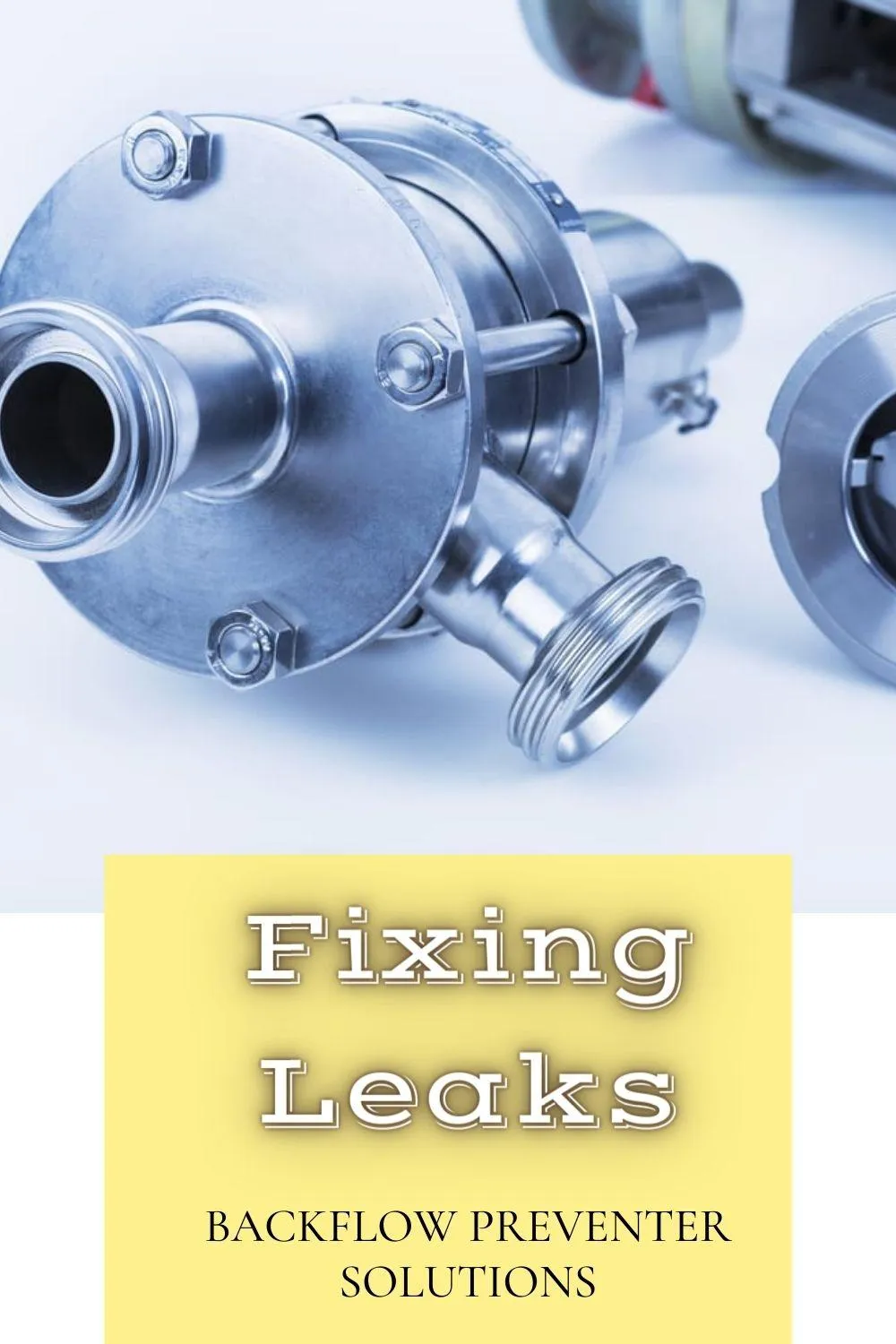Phone: (559) 272-4265
Appliance Repair Tips For Bakersfield, CA Residents

Leak No More: Backflow Preventer Fix Guide
Fixing Leaks: Backflow Preventer Solutions
Introduction:
Welcome to the Ultimate Backflow Preventer Fix Guide, brought to you by Zip Appliance and Plumbing Repair in Bakersfield, California.
Understanding the Importance of Fixing Backflow Issues
Backflow is a serious plumbing concern that can compromise the safety and quality of your water supply. By allowing contaminated water to flow back into clean water lines, backflow poses health risks and can lead to waterborne illnesses. Addressing backflow issues promptly is crucial to safeguarding the health and well-being of your household and community.

Overview of Common Causes of Backflow Leaks
Several factors can contribute to backflow leaks, including:
Pressure imbalances in the water system
Cross-connections between potable and non-potable water sources
Malfunctioning backflow preventer components
Corrosion and deterioration of plumbing materials
Understanding these common causes is essential for effectively diagnosing and resolving backflow problems.
Section 1: Identifying Backflow Preventer Issues
Signs and Symptoms of a Leaking Backflow Preventer
Detecting backflow preventer issues early is key to preventing water damage and contamination. Look out for the following signs and symptoms:
Visible Water Leakage
Visible puddles or drips around the backflow preventer assembly indicate a potential leak in the system.
Decreased Water Pressure
A sudden drop in water pressure throughout your plumbing fixtures may signal a backflow preventer malfunction.
Strange Noises
Unusual noises such as gurgling or hissing sounds coming from the backflow preventer could indicate a problem with the valve or seals.
Fluctuating Water Temperature
Inconsistent water temperatures, particularly in hot water lines, may indicate backflow issues affecting the heating system.
Conducting a Visual Inspection
Regular visual inspections of the backflow preventer assembly can help identify any visible signs of damage or deterioration.
Checking for Corrosion
Inspect the components of the backflow preventer for signs of corrosion, which can weaken the integrity of the system.
Assessing Valve Integrity
Ensure that all valves within the backflow preventer are functioning properly and sealing tightly to prevent backflow.
Examining Pipe Connections
Inspect the connections between pipes and fittings for any signs of leaks or loose connections that may compromise the integrity of the system.
Section 2: Tools and Materials Needed for Fixing
Essential Tools for Backflow Preventer Repair
Before embarking on any repair work, gather the following tools and materials:
Wrenches
Adjustable wrenches or pipe wrenches will be needed to loosen and tighten fittings during the repair process.
Pipe Cutter
A pipe cutter is essential for cutting and removing sections of pipe that may need replacement.
Teflon Tape
Teflon tape, also known as plumber's tape, is used to create a watertight seal when assembling pipe connections.
Replacement Parts
Depending on the nature of the repair, you may need replacement parts such as valves, seals, or fittings.
Safety Gear for DIY Repair Projects
Protective Gloves
Wear sturdy gloves to protect your hands from sharp edges and potential exposure to contaminants.
Safety Goggles
Safety goggles will shield your eyes from debris and splashing water during the repair process.
Work Gloves
Durable work gloves provide added protection and grip when handling tools and materials.
Section 3: DIY Backflow Preventer Fixes
Step-by-Step Repair Process
Follow these steps to repair a leaking backflow preventer:
Shutting Off Water Supply
Begin by shutting off the water supply to the backflow preventer to prevent further leakage or contamination.
Draining the System
Open faucets and valves downstream of the backflow preventer to drain any remaining water from the system.
Disassembling the Backflow Preventer
Carefully disassemble the backflow preventer assembly, taking note of the position of each component for reassembly.
Cleaning and Lubricating Parts
Clean all components thoroughly with water and a mild detergent, then lubricate moving parts as needed to ensure smooth operation.
Replacing Faulty Components
Replace any damaged or worn components, such as valves, seals, or O-rings, with new ones to restore the integrity of the system.
Troubleshooting Common Issues
Address specific issues such as leaky valves, damaged seals, corrosion, or clogged pipes using appropriate repair techniques.
Section 4: Professional Help and Maintenance Tips
When to Seek Professional Assistance
In some cases, backflow preventer issues may require professional intervention, particularly if the repairs are complex or pose safety concerns.
Complex Repairs
If you encounter challenges during the repair process or lack the necessary expertise, it's best to consult a qualified plumber or technician for assistance.
Safety Concerns
Issues such as gas leaks, electrical hazards, or structural damage may pose safety risks that require professional handling.
Preventative Maintenance Practices
To prevent future backflow issues, implement the following maintenance practices:
Regular Inspections
Schedule routine inspections of your backflow preventer system to detect and address any potential problems early on.
Cleaning and Flushing
Periodically clean and flush the backflow preventer assembly to remove sediment and debris that could impede its function.
Annual Maintenance Checks
Consider scheduling annual maintenance checks with a qualified technician to ensure the continued reliability and effectiveness of your backflow preventer system.
Section 5: FAQs and Expert Tips
Answers to Commonly Asked Questions
Can I DIY Backflow Preventer Repair?
While some minor repairs can be tackled DIY, more complex issues may require professional assistance to ensure proper resolution.
How Often Should Backflow Preventers Be Checked?
It's recommended to have your backflow preventer system inspected annually by a qualified technician to maintain its performance and compliance with regulations.
What Are the Consequences of Ignoring Leaks?
Ignoring backflow leaks can lead to water contamination, property damage, and potential health hazards for occupants.
Expert Tips for Effective Backflow Preventer Maintenance
Proper Installation Practices
Ensure that your backflow preventer system is installed correctly and complies with local plumbing codes and regulations.
Importance of Timely Repairs
Address any backflow preventer issues promptly to prevent further damage and maintain the integrity of your plumbing system.
Water Conservation Strategies
Implement water conservation measures to reduce the strain on your plumbing system and minimize the risk of backflow issues.
Conclusion
Recap of Key Points
In summary, addressing backflow preventer issues promptly and effectively is crucial for maintaining the safety and integrity of your water supply.
Empowering Readers to Tackle Backflow Issues
By providing the knowledge and resources needed to identify, diagnose, and repair backflow preventer problems, this guide empowers readers to take control of their plumbing challenges.
Encouragement to Implement Preventative Measures
We encourage readers to implement preventative maintenance practices and seek professional assistance when needed to ensure the continued reliability and performance of their backflow preventer systems.
For expert plumbing and appliance repair services in Bakersfield, California, trust Zip Appliance and Plumbing Repair. We specialize in servicing water heaters, leaking pipes, shut off valves, toilets, and replacing PVC pipes. Contact us today at (661) 387-2282 or visit our website at www.ziprepairservice.com to schedule an appointment or learn more about our services.

Leak No More: Backflow Preventer Fix Guide
Fixing Leaks: Backflow Preventer Solutions
Introduction:
Welcome to the Ultimate Backflow Preventer Fix Guide, brought to you by Zip Appliance and Plumbing Repair in Bakersfield, California.
Understanding the Importance of Fixing Backflow Issues
Backflow is a serious plumbing concern that can compromise the safety and quality of your water supply. By allowing contaminated water to flow back into clean water lines, backflow poses health risks and can lead to waterborne illnesses. Addressing backflow issues promptly is crucial to safeguarding the health and well-being of your household and community.

Overview of Common Causes of Backflow Leaks
Several factors can contribute to backflow leaks, including:
Pressure imbalances in the water system
Cross-connections between potable and non-potable water sources
Malfunctioning backflow preventer components
Corrosion and deterioration of plumbing materials
Understanding these common causes is essential for effectively diagnosing and resolving backflow problems.
Section 1: Identifying Backflow Preventer Issues
Signs and Symptoms of a Leaking Backflow Preventer
Detecting backflow preventer issues early is key to preventing water damage and contamination. Look out for the following signs and symptoms:
Visible Water Leakage
Visible puddles or drips around the backflow preventer assembly indicate a potential leak in the system.
Decreased Water Pressure
A sudden drop in water pressure throughout your plumbing fixtures may signal a backflow preventer malfunction.
Strange Noises
Unusual noises such as gurgling or hissing sounds coming from the backflow preventer could indicate a problem with the valve or seals.
Fluctuating Water Temperature
Inconsistent water temperatures, particularly in hot water lines, may indicate backflow issues affecting the heating system.
Conducting a Visual Inspection
Regular visual inspections of the backflow preventer assembly can help identify any visible signs of damage or deterioration.
Checking for Corrosion
Inspect the components of the backflow preventer for signs of corrosion, which can weaken the integrity of the system.
Assessing Valve Integrity
Ensure that all valves within the backflow preventer are functioning properly and sealing tightly to prevent backflow.
Examining Pipe Connections
Inspect the connections between pipes and fittings for any signs of leaks or loose connections that may compromise the integrity of the system.
Section 2: Tools and Materials Needed for Fixing
Essential Tools for Backflow Preventer Repair
Before embarking on any repair work, gather the following tools and materials:
Wrenches
Adjustable wrenches or pipe wrenches will be needed to loosen and tighten fittings during the repair process.
Pipe Cutter
A pipe cutter is essential for cutting and removing sections of pipe that may need replacement.
Teflon Tape
Teflon tape, also known as plumber's tape, is used to create a watertight seal when assembling pipe connections.
Replacement Parts
Depending on the nature of the repair, you may need replacement parts such as valves, seals, or fittings.
Safety Gear for DIY Repair Projects
Protective Gloves
Wear sturdy gloves to protect your hands from sharp edges and potential exposure to contaminants.
Safety Goggles
Safety goggles will shield your eyes from debris and splashing water during the repair process.
Work Gloves
Durable work gloves provide added protection and grip when handling tools and materials.
Section 3: DIY Backflow Preventer Fixes
Step-by-Step Repair Process
Follow these steps to repair a leaking backflow preventer:
Shutting Off Water Supply
Begin by shutting off the water supply to the backflow preventer to prevent further leakage or contamination.
Draining the System
Open faucets and valves downstream of the backflow preventer to drain any remaining water from the system.
Disassembling the Backflow Preventer
Carefully disassemble the backflow preventer assembly, taking note of the position of each component for reassembly.
Cleaning and Lubricating Parts
Clean all components thoroughly with water and a mild detergent, then lubricate moving parts as needed to ensure smooth operation.
Replacing Faulty Components
Replace any damaged or worn components, such as valves, seals, or O-rings, with new ones to restore the integrity of the system.
Troubleshooting Common Issues
Address specific issues such as leaky valves, damaged seals, corrosion, or clogged pipes using appropriate repair techniques.
Section 4: Professional Help and Maintenance Tips
When to Seek Professional Assistance
In some cases, backflow preventer issues may require professional intervention, particularly if the repairs are complex or pose safety concerns.
Complex Repairs
If you encounter challenges during the repair process or lack the necessary expertise, it's best to consult a qualified plumber or technician for assistance.
Safety Concerns
Issues such as gas leaks, electrical hazards, or structural damage may pose safety risks that require professional handling.
Preventative Maintenance Practices
To prevent future backflow issues, implement the following maintenance practices:
Regular Inspections
Schedule routine inspections of your backflow preventer system to detect and address any potential problems early on.
Cleaning and Flushing
Periodically clean and flush the backflow preventer assembly to remove sediment and debris that could impede its function.
Annual Maintenance Checks
Consider scheduling annual maintenance checks with a qualified technician to ensure the continued reliability and effectiveness of your backflow preventer system.
Section 5: FAQs and Expert Tips
Answers to Commonly Asked Questions
Can I DIY Backflow Preventer Repair?
While some minor repairs can be tackled DIY, more complex issues may require professional assistance to ensure proper resolution.
How Often Should Backflow Preventers Be Checked?
It's recommended to have your backflow preventer system inspected annually by a qualified technician to maintain its performance and compliance with regulations.
What Are the Consequences of Ignoring Leaks?
Ignoring backflow leaks can lead to water contamination, property damage, and potential health hazards for occupants.
Expert Tips for Effective Backflow Preventer Maintenance
Proper Installation Practices
Ensure that your backflow preventer system is installed correctly and complies with local plumbing codes and regulations.
Importance of Timely Repairs
Address any backflow preventer issues promptly to prevent further damage and maintain the integrity of your plumbing system.
Water Conservation Strategies
Implement water conservation measures to reduce the strain on your plumbing system and minimize the risk of backflow issues.
Conclusion
Recap of Key Points
In summary, addressing backflow preventer issues promptly and effectively is crucial for maintaining the safety and integrity of your water supply.
Empowering Readers to Tackle Backflow Issues
By providing the knowledge and resources needed to identify, diagnose, and repair backflow preventer problems, this guide empowers readers to take control of their plumbing challenges.
Encouragement to Implement Preventative Measures
We encourage readers to implement preventative maintenance practices and seek professional assistance when needed to ensure the continued reliability and performance of their backflow preventer systems.
For expert plumbing and appliance repair services in Bakersfield, California, trust Zip Appliance and Plumbing Repair. We specialize in servicing water heaters, leaking pipes, shut off valves, toilets, and replacing PVC pipes. Contact us today at (661) 387-2282 or visit our website at www.ziprepairservice.com to schedule an appointment or learn more about our services.
If your dryer has been giving you problems, contact Zip Appliance Repair & Service at (661) 387-2282

Appliance Repair In A Zip
If you need a dryer repair call our Team at (661) 387-2282, or visit our online scheduling page to request service.
Appliance Repair
Plumbing Repair Services
HAVE A QUESTION, CALL (661) 387-2282

Online Offers
Take advantage of our online discount offers - save time and money...

Residential & Commercial appliances
See what our company can do for you

Appliance Repair Tips
If your appliance is not working properly...

1405 Commercial Way ste 100
Bakersfield, CA 93309
Lic # 1116346
Equipment We Sevice
- A Call To Confirm Your Appointment Time
- A Email Detailing Your Assigned Technician
- Information Needed Before The Repair Can Be Started
- An Estimate Of Work To Be Done
© 2024 ZIP APPLIANCE REPAIR & SERVICE LLC








